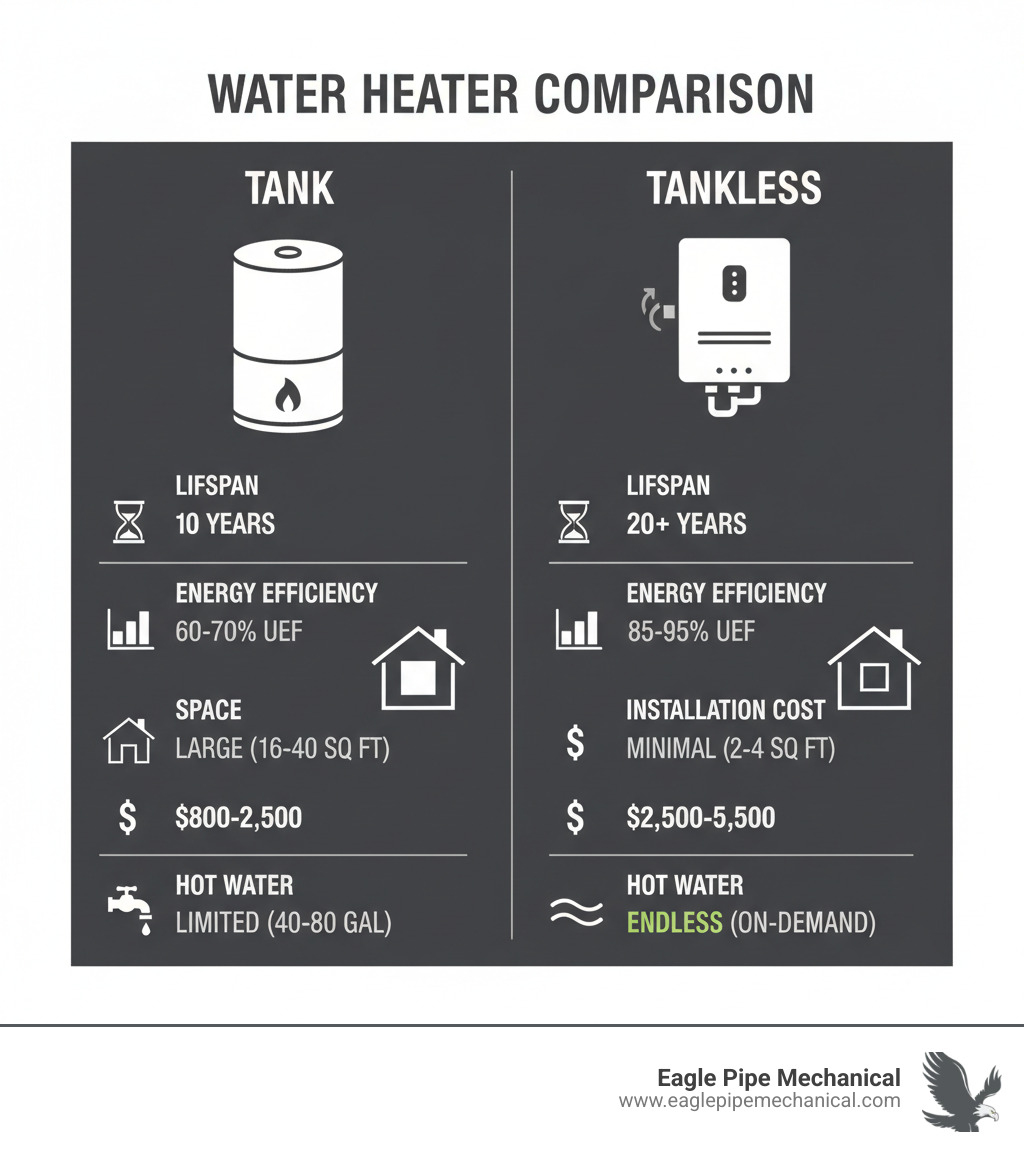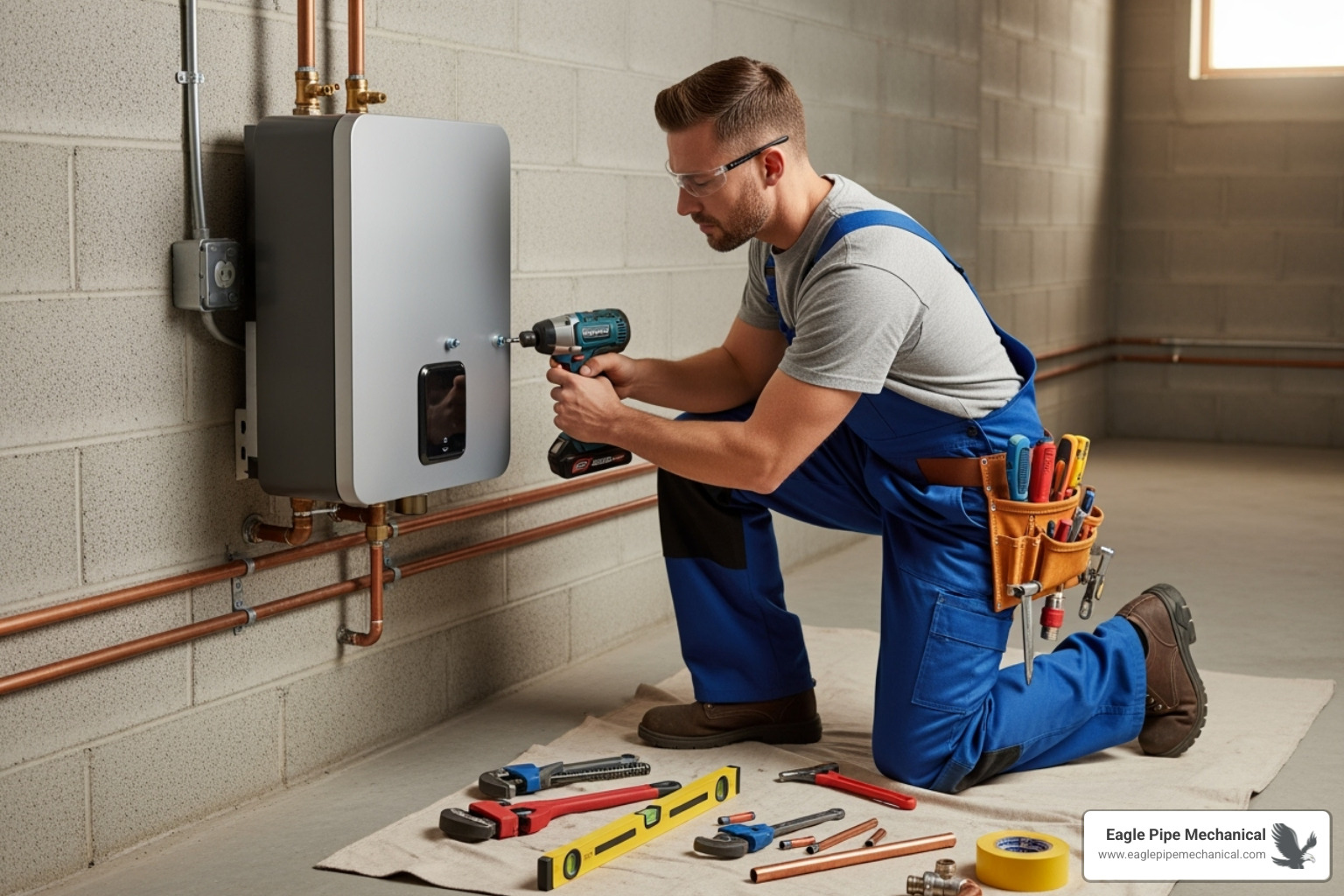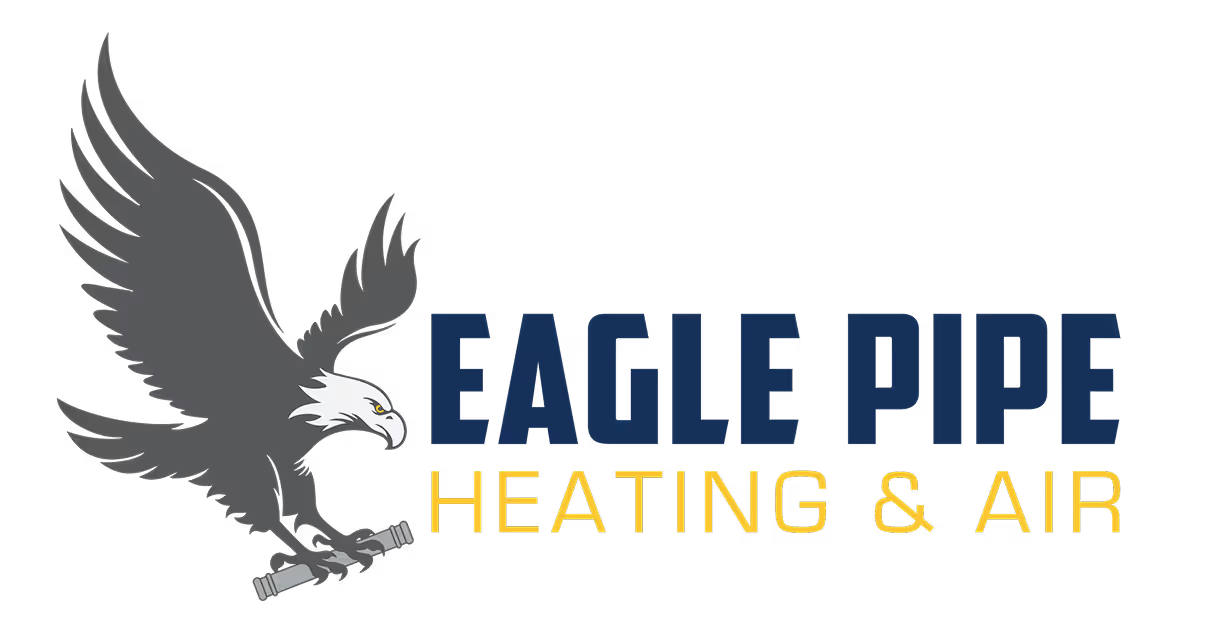From Tank to Tankless: The Ultimate Installation Walkthrough

Why Tankless Water Heater Installation is Changing Home Comfort
Tankless water heater installation is a popular home upgrade for good reason. These compact, wall-mounted units deliver endless hot water while saving up to 35% on energy costs compared to traditional tank heaters.
Quick Installation Overview:
- Professional installation required for safety and code compliance
- 4-8 hours for new installations, 1-3 hours for replacements
- Key requirements: proper gas line sizing, electrical circuits, and venting
- Cost range: $2,500-$5,500 including installation
- Energy savings: Up to 40% more efficient than tank gas heaters, 55% more than electric tanks
Unlike traditional water heaters that constantly heat 40-80 gallons of stored water, tankless units heat water on-demand as it flows through the system. This eliminates standby heat loss—the energy wasted keeping a tank hot 24/7.
The benefits extend beyond energy savings. Tankless water heaters last over 20 years compared to 10 years for tank models, take up minimal wall space, and provide continuous hot water for multiple simultaneous uses.
However, proper installation is critical. As one plumbing professional noted: "Gas-powered tankless heaters require careful handling of gas lines, supply gas pressure, and proper venting to ensure safety." DIY installation risks include gas leaks, carbon monoxide poisoning, and voiding manufacturer warranties.
For homeowners in Kitsap and Jefferson Counties, understanding the installation process, costs, and requirements is key to making an informed decision about this significant home improvement.

Pre-Installation Checklist: Sizing and Selecting Your Unit
Choosing the right tankless water heater is a critical step in the tankless water heater installation process. An incorrect choice can lead to lukewarm showers or high energy bills. Our experience helping homeowners in Kitsap and Jefferson Counties shows that understanding a few key factors makes the decision clear.
Key considerations include fuel type (gas vs. electric), flow rate in gallons per minute (GPM), BTU input, Uniform Energy Factor (UEF) for efficiency, and temperature rise—the difference between incoming water temp and your desired output. You'll also choose between condensing and non-condensing units. Condensing models use a second heat exchanger for extra efficiency, making them more efficient but slightly more expensive upfront. For a comprehensive look at all your options, check out our guide on Choosing the Best Water Heaters.
Gas vs. Electric: Key Differences
Both gas and electric tankless units provide endless hot water, but they have distinct installation and operational differences.
FeatureGas Tankless Water HeaterElectric Tankless Water HeaterUpfront CostGenerally higher for the unit, plus potential gas line and venting upgrades.Often lower for the unit, but can incur significant electrical upgrade costs.Operating CostTypically lower, especially if natural gas is cheaper than electricity in your area.Can be higher if electricity rates are high, but 55% more energy efficient than electric tank units.Installation ComplexityMore complex due to gas line sizing and venting requirements.Simpler if existing electrical capacity is sufficient; complex if panel upgrades are needed.Flow Rate CapabilitiesHigher flow rates, ideal for larger homes or simultaneous hot water demands.Lower flow rates, generally better for smaller homes or point-of-use applications.Venting RequirementsEssential for expelling combustion gases (direct-vent, power-vent).None required, which simplifies placement.Electrical NeedsA standard 120V outlet for controls; no major electrical upgrades typically needed.Often requires dedicated circuits (e.g., two to three 40 amp 240 VAC breakers) and potential panel upgrades.
Gas units are powerful, up to 40% more energy efficient than gas tank heaters, and can handle high hot water demands. However, they require proper venting and may need gas line upgrades for their high BTU input.
Electric units are 55% more energy efficient than electric tank heaters and don't require venting, making them ideal for smaller homes. Their main drawback is the potential need for significant electrical upgrades, including dedicated circuits or a new panel, which adds to the cost. In Washington, gas units are often more popular due to affordable natural gas rates and the higher flow rates families need.
Calculating Your Home's Hot Water Needs
Calculating your home's needs focuses on peak demand, not total daily usage. It’s about those busy times when multiple fixtures are running at once. We start by looking at simultaneous use patterns.
Typical fixture demands are: Faucets (0.75-2.5 GPM), low-flow shower heads (1.2-2 GPM), older shower heads (2.5-3.5 GPM), and dishwashers or washing machines (1-2 GPM each). If you run a 2.5 GPM shower and a 1.5 GPM dishwasher simultaneously, your peak demand is 4 GPM.
Another key factor is temperature rise. In the Pacific Northwest, cold groundwater (45-50°F) needs to be heated to a comfortable 120°F, requiring a 70-75°F temperature rise. A larger rise demands a higher BTU input from the unit.
We recommend sizing your unit slightly above your peak demand to ensure you always have enough hot water. Also, consider the Uniform Energy Factor (UEF); a higher rating means lower operating costs. For more detailed guidance, our article on Selecting Right Home Water Heaters walks through the entire selection process.
The Professional Tankless Water Heater Installation Process
After selecting your unit, the professional tankless water heater installation begins. Our team at Eagle Pipe Mechanical takes pride in performing this work correctly and safely the first time.

Safety is our top priority. We strictly follow all local building codes, manufacturer specifications, and secure necessary permits. This project demands professional expertise due to the complexities of gas, electrical, and venting systems. For more details on our systematic approach, check out our Water Heater Installation Steps guide.
Step 1: Site Assessment and Homeowner Preparation
We begin with a thorough site assessment to understand your home's specific layout.
- Clearing the installation area ensures our team can work safely and efficiently.
- Selecting the optimal location is crucial. We consider proximity to utilities, venting needs (for gas models), and future maintenance access.
- Ensuring access to utilities involves locating the main water shut-off, gas valve, and electrical panel.
- To remove your old tank heater, we first shut off all utilities. We then drain the tank completely before carefully disconnecting all lines. We also handle the proper disposal and recycling of your old unit as part of our service.
Step 2: Mounting and Connecting the New Unit
Now we install your new tankless system with the precision that comes from years of experience.

- Wall mounting requires securing the unit to wall studs to ensure it is level and supported, preventing vibration and noise.
- For water line connections, we use copper or flexible stainless steel lines, installing shut-off valves for future maintenance and using Teflon tape to prevent leaks.
- For gas line connections, upgrades are often necessary. A tankless unit can demand 90,000-130,000 BTU/hr, often requiring an upgrade to a 3/4-inch or 1-inch gas line. We install a shut-off valve and sediment trap, then test every connection for leaks.
- Electrical wiring for gas models usually requires a standard 120V outlet. Electric units are more demanding, often needing dedicated high-amperage circuits and potential panel upgrades, all installed to meet safety codes.
- A pressure relief valve is a critical safety feature we install per manufacturer specifications to release excess pressure and prevent overheating.
Why Professional Tankless Water Heater Installation is Non-Negotiable
While the DIY spirit is strong, tankless water heater installation is a job for professionals due to serious safety risks.
- Gas leaks and carbon monoxide poisoning: According to ENERGY STAR safety information, proper installation and venting are crucial. Improper connections or venting can create invisible, deadly hazards.
- Electrical hazards: Incorrect wiring of high-amperage units can cause fires and shocks.
- Voiding your warranty: Most manufacturers require installation by a licensed professional to honor the warranty.
- Improper venting: Tankless units require specific venting materials (PVC or stainless steel) and placement, which DIYers often get wrong.
- Code compliance: Our licensed plumbers ensure your installation meets all Kitsap and Jefferson County codes, protecting your family and your insurance coverage.
The bottom line? Trust professionals with this investment. For more information, visit our Essential Water Heater Installation page.
Explaining the Costs and Requirements
Understanding the cost of a tankless water heater installation is important. It's a significant investment, but one that pays off.
A complete installation typically costs $2,500 to $5,500. While more than a traditional tank ($1,200-$2,500), the long-term value comes from energy savings up to 35% and a lifespan of over 20 years—double that of tank heaters. You'll enjoy your tankless unit long after a traditional tank would need replacement. Plus, rebates and financing options can reduce the initial cost. Our guide on When to Consider Water Heater Replacement explores these financial considerations.
Key Factors Influencing Your Tankless Water Heater Installation Cost
Several factors influence the final installation cost:
- Unit and Labor Costs: The unit itself can range from a few hundred dollars to over $2,000 for high-output models. Labor costs typically add $500 to $1,500, depending on complexity.
- Location Complexity: An accessible utility room is less expensive to work in than a cramped crawlspace or attic.
- Gas vs. Electric: This choice is a major cost factor. Gas units may need venting and gas line upgrades, while electric units can require expensive panel upgrades ($1,500+).
- Venting Requirements: For gas units, a simple, short vent run costs less than a complex one. The materials (PVC or stainless steel) and length add to the cost.
- Permits and Inspections: These are required in Kitsap and Jefferson Counties. This modest fee is essential for safety and insurance compliance. For more insights, check out Opting for Water Heater Replacement.
Specific Requirements: Gas and Electric Models
The technical requirements for gas and electric models directly impact the cost and complexity of your tankless water heater installation.
Gas tankless units demand 90,000 to 130,000+ BTU/H, far more than a tank's 30,000 BTU/H. This often requires upgrading the gas line to 3/4-inch or 1-inch. For venting materials, gas units require direct-vent systems with PVC for condensing units or stainless steel for non-condensing models, installed with precise clearances for safety.
Electric tankless units are power-hungry, often needing two to three dedicated 40-amp, 240-volt circuits. This frequently requires an electrical panel upgrade. The advantage of electric units is that no venting is required, allowing for more flexible placement.
Both types require professional expertise to ensure safe, code-compliant installation. That's why we specialize in Expert Water Heater Installation Services.
Post-Installation: Maintenance and Troubleshooting
After your tankless water heater installation, proper maintenance is key to ensuring it runs efficiently for its 20+ year lifespan. Regular care protects your investment, maintains peak efficiency, and ensures longevity. Fortunately, the maintenance is straightforward.

We recommend an annual maintenance schedule for optimal performance. For a complete guide, see our page on Tankless Water Heater Maintenance.
Keeping Your Unit in Peak Condition
Consistent maintenance is crucial, especially in Kitsap and Jefferson Counties where water quality can vary.
- Descaling and flushing is the most important task, especially with hard water. An annual flush with a vinegar solution removes mineral buildup from the heat exchanger. Our article on Sediment Buildup in Your Water Heater explains why this is so crucial.
- Cleaning the water filter is a simple, vital task. The inline filter catches sediment, and we can show you how to rinse it clean.
- For gas units, inspecting vent pipes annually is crucial. Blockages from debris or nests can reduce efficiency and create a carbon monoxide hazard.
- Checking error codes on the digital display helps diagnose issues. We can help you understand what they mean and when to call a professional.
Common Issues and When to Call a Pro
Even well-maintained units can have issues. It's important to know when to call a pro.
- Inconsistent water temperature, or a "cold water sandwich," can be caused by flow rate issues, improper sizing, or mineral buildup that requires a professional.
- Low water pressure may be a plumbing issue, but if combined with temperature fluctuations, mineral buildup in the unit could be the cause and needs professional assessment.
- Strange noises like popping or rumbling usually indicate mineral deposits in the heat exchanger that need to be removed by descaling. Our page on Tankless Water Heater Strange Noises can help.
- Ignition failure in a gas unit is not a DIY fix. For safety, call a professional immediately to address gas supply, igniter, or sensor problems.
- If your unit stops producing hot water, check the power and error codes first. If the problem persists, it requires professional diagnosis.
Our rule of thumb: if it involves gas or electrical components, or if simple troubleshooting fails, give us a call. Our team can help you Solve Tankless Water Heater Issues safely and efficiently.
Frequently Asked Questions about Tankless Installation
Here are answers to the most common questions we receive about tankless water heater installation.
How long does a tankless water heater installation take?
Replacing an old tank heater with a new tankless system typically takes 4 to 8 hours. This includes removing the old unit, making necessary gas or electrical upgrades, installing venting, and testing. Replacing an existing tankless unit is much faster, usually taking 1 to 3 hours.
The timeline can be extended by complex gas line or electrical upgrades, or difficult venting routes. We always take the time needed to do the job right.
Can I install a tankless water heater myself?
While DIY installation is tempting, tankless water heater installation is a job for professionals due to significant safety risks. The work involves high-demand gas lines, high-amperage electrical circuits, and precise venting to prevent carbon monoxide. Mistakes can lead to gas leaks, fires, or other dangerous conditions.
Furthermore, most manufacturers will void your warranty if the unit is not installed by a licensed professional, leaving you responsible for any repairs. Our licensed team knows the local codes in Kitsap and Jefferson Counties, ensuring your installation is safe and compliant. For guidance on professional standards, check out our Successful Water Heater Installation page.
Are there rebates for installing a tankless water heater?
Yes! Installing a high-efficiency tankless water heater often qualifies you for money-saving programs.
- Federal tax credits are often available for Energy Star-certified models. We can help you check current guidelines.
- State and local programs in Washington may also offer incentives. We stay current on available programs in Kitsap and Jefferson Counties.
- Utility companies often provide rebates for high-efficiency units because they reduce overall energy demand.
We can help you select a qualifying model and provide the necessary documentation for your applications, potentially saving you hundreds of dollars.
Your Local Experts for a Flawless Installation
Upgrading to a tankless water heater is a smart home improvement. You get significant energy savings (up to 35%), more space, and an endless supply of hot water.
However, the benefits depend on a flawless installation. Tankless water heater installation is not a DIY project; it requires professional expertise in gas, electrical, and venting systems to avoid safety hazards and ensure performance.
Eagle Pipe Mechanical is the trusted choice for homeowners in Kitsap and Jefferson Counties. Our licensed professionals provide tankless water heater installation done right the first time, understanding the specific needs of Pacific Northwest homes and local codes.
We protect your investment by properly sizing your unit and ensuring every part of the installation meets the highest standards, avoiding costly future repairs. As your local experts, we prioritize knowledgeable, honest, and efficient service on every job.
Ready for endless hot water and lower energy bills? Our team specializes in Plumbing Poulsbo WA Water Heater Installation and serves communities throughout our region. Contact Eagle Pipe Mechanical today to schedule your consultation and find why so many homeowners trust us with their home comfort upgrades.
CUSTOMER TESTIMONIALS
Our customers’ experiences say more than we ever could. See how Eagle Pipe Heating & Air has earned trust across the Pacific Northwest with reliable service and lasting results.





